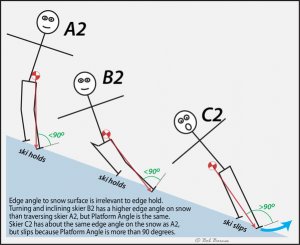In this thread, carving means tail follows tip, with skis scribing pencil-thin lines in the hard snow, arc-to-arc carving.
Let's make a list.
If there are disagreements, we can discuss our differences of opinion with civility. I'll start.
1. Skier must be able to tip skis without turning them. Since so much of skiing involves turning the skis, habitual turning of the skis gets in the way of learning to carve.
2. Since the tip needs to scribe a line, and the tail needs to scribe the same line, both ends of the ski need to be pressing onto the hard snow. So skier needs to stay over the ski(s) in a way that distributes the pressure to both tip and tail.
3. Skier can carve on two skis (railroad tracks) or the outside ski (most or all weight on the outside ski) or the inside ski i(carved white pass turns).
4. Skier must be able to balance on/over/against the ski (assuming outside ski is dominant) with less than 90% platform angle. This angle is different from the ski's edge angle to the snow. This image by Bob Barnes explains this concept.

5. Skis need sharp edges for carving on hard snow. They will slip otherwise, unless the skier is a ski god with absolutely perfect form and timing.
4. Skis need camber and parabolic shape. These two provide help in getting both the tip and the tail pressed onto the snow through the entire turn. Reverse cambered skis, straight skis, and spatulas are not going to carve on hard snow. Fully rockered skis (without any camber) are going to be difficult to carve on hard snow but with wide tails and tips that can grip and a very good skier it can be done.
5. Skis that are torsionally stiff hold their shape and help the tip and tail bite the snow. So torsional stiffness is essential. A torsionally soft beginner ski isn't going to hold a carve on hard snow. Well, maybe it will at very slow speeds on low pitch terrain (railroad tracks).
*6. Skis with a narrow waist make carving on hard snow easier, but are not absolutely necessary. The waist determines how fast the skier can get the ski tipped. Narrower waist = faster onto edge = quicker to achieve high edge angles = more precision when making short turns.
*7. Carving can be done with low ski-to-snow edge angles (railroad tracks), medium or high edge angles. So high edge angles are not necessary. Edge angle determines how much the ski bends and therefore it determines the radius of the turn. Higher edge angle = shorter turn.
Anyone disagree?
What am I forgetting?
.
Let's make a list.
If there are disagreements, we can discuss our differences of opinion with civility. I'll start.
1. Skier must be able to tip skis without turning them. Since so much of skiing involves turning the skis, habitual turning of the skis gets in the way of learning to carve.
2. Since the tip needs to scribe a line, and the tail needs to scribe the same line, both ends of the ski need to be pressing onto the hard snow. So skier needs to stay over the ski(s) in a way that distributes the pressure to both tip and tail.
3. Skier can carve on two skis (railroad tracks) or the outside ski (most or all weight on the outside ski) or the inside ski i(carved white pass turns).
4. Skier must be able to balance on/over/against the ski (assuming outside ski is dominant) with less than 90% platform angle. This angle is different from the ski's edge angle to the snow. This image by Bob Barnes explains this concept.

5. Skis need sharp edges for carving on hard snow. They will slip otherwise, unless the skier is a ski god with absolutely perfect form and timing.
4. Skis need camber and parabolic shape. These two provide help in getting both the tip and the tail pressed onto the snow through the entire turn. Reverse cambered skis, straight skis, and spatulas are not going to carve on hard snow. Fully rockered skis (without any camber) are going to be difficult to carve on hard snow but with wide tails and tips that can grip and a very good skier it can be done.
5. Skis that are torsionally stiff hold their shape and help the tip and tail bite the snow. So torsional stiffness is essential. A torsionally soft beginner ski isn't going to hold a carve on hard snow. Well, maybe it will at very slow speeds on low pitch terrain (railroad tracks).
*6. Skis with a narrow waist make carving on hard snow easier, but are not absolutely necessary. The waist determines how fast the skier can get the ski tipped. Narrower waist = faster onto edge = quicker to achieve high edge angles = more precision when making short turns.
*7. Carving can be done with low ski-to-snow edge angles (railroad tracks), medium or high edge angles. So high edge angles are not necessary. Edge angle determines how much the ski bends and therefore it determines the radius of the turn. Higher edge angle = shorter turn.
Anyone disagree?
What am I forgetting?
.
Last edited: